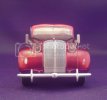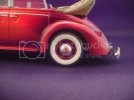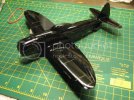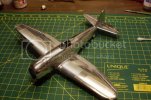GEE,
I've recently used AlClad & had great results. I actually used Their Primer, & Base Gloss Black. They also make an Aqua Gloss Clear ( it's acrylic ) - You may ask yourself ... "what's th difference between that & Future". ... The Aqua Gloss Clear is thinner than th Future & it goes down a lot easier.
SCOTT is correct about letting the base coat fully cure. I had talked to th AlClad Factory Rep. & while using Their Gloss Black Base he suggested letting it cure for 4-6 days , as it's an Enamel/Lacquer base paint. If you don't let it cure fully then you run th risk of the AlClad cracking as it cures, b/c the Base coat will shrink ( Enamel & Lacquer) as it cures, thus leading to the Cracking of the AlClad on top of the Base Coat. You are also gonna want to use some Very Fine Sand paper/Micro Mesh to smooth out the Finish of the Base Coat. ALClad will Show any blemishes on it. It goes on Very Thin ! Also ... You will want to coat the Finished product to protect the Chrome of Metallic finish. I used Their Aqua Gloss Clear with Great Results & I was able to use some 3M Blue Painters Tape( Low Tack) & with th Aqua Gloss protector coat the Chrome didn't come off with th tape.
You also wanna shoot th AlClad @ 12-15 psi & Mist it on & I do mean Mist. Check Their site out & any other Questions that you have you can drop them a note under "Contact Us" TONY is Great about answering Questions.
-
http://www.alclad2.com/
Also here's a YOUTUBE Video that I found ... A Guy demo's how to shoot th Chrome on in short Misting bursts.
Tutorial : Chroming with Alclad
See how He uses the short Bursts . That's th way to do it.
Here are some Pix of My Opel Admiral that I painted with AlClad


If you look Close you can see th Reflection of theBumper in the Paint on th car.


Here's th Method that I used on th Opel :
AlClad Black Primer/Microfiller
" " Gloss Black Base - let cure for 6 days
" " Chrome - I only misted 2 coats on ! ANy more & you run th risk of making the Chrome "Cloudy"
" " I misted 2 coats of the AlClad Aqua Gloss Clear - let cure for 24 hours & then I taped off the Chrome Pieces- Grill, Body Chrome, * The Hub Caps were painted off of the Car
AlClad Transparent Red - I misted 3 coats on the Body & the n removed the Tape
" " Aqua Gloss Clear - I misted 2 coats on the Entire Car ( minus the Clear parts) & let cure for 24 hours - & That was it. I was very happy with th way that it came out. There is some slight Orange Peel in the finish, but that was My Fault as when I shot the Gloss Black Base , at times I held th AB too far away from the Car. The Peel had shown through the Chrome & th Transparent Red ... Something that I didn't think would happen .. but that's just how thin th Chrome & Red AlClad goes on !!
;D
I hope that Helps ....








